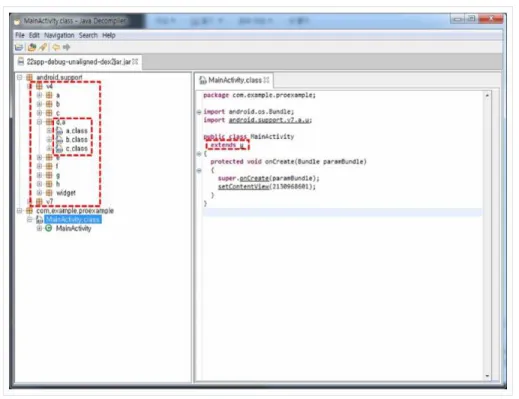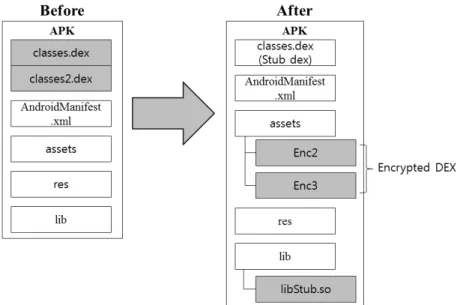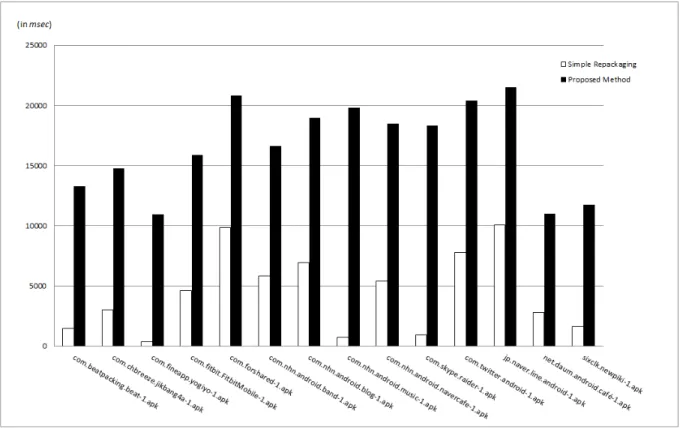Engineering based on Multidexing
Nak Young Kim1, Jaewoo Shim1, Seong-je Cho1, Minkyu Park2∗, and Sanghcul Han2 1Dankook University, Yongin, Gyeonggi 16890 Korea
{iuasdofil, 32131715, sjcho}@dankook.ac.kr 2Konkuk University, Chungju, Chungbuk 27478 Korea
{minkyup, schan}@kku.ac.kr
Abstract
DEX files are executable files of Android applications. Since DEX files are in the format of Java bytecodes, their Java source codes can be easily obtained using static reverse engineering tools. This results in numerous Android application thefts. There are some tools (e.g. bangcle, ijiami, liapp) that protect Android applications against static reverse engineering utilizing dynamic code loading. These tools usually encryptclasses.dexin an APK file. When the application is launched, the en-cryptedclasses.dexfile is decrypted and dynamically loaded. However, these tools fail to protect multidex APKs, which include more than one DEX files (classes2.dex, classes3.dex, ...) to accommodate large-sized execution codes. In this paper, we propose a technique that protects multidex Android applications against static reverse engineering. The technique can encrypt/decrypt multiple DEX files in APK files and dynamically load them. The experimental results show that the proposed technique can effiectively protect multidex APKs.
Keywords: Android, Reverse engineering, Multidex, Dynamic code loading, Packing
1
Introduction
In recent days, as the use of mobile devices (e.g. smartphones and smart watches) increases , the number of Android applications grows explosively. The number of Android applications is greater than 2 million in 2016 [7]. Protecting Android applications against software theft becomes one of important issues. Most Android applications are developed using Java programming language. Java source codes are compiled into bytecodes and unfortunately bytecodes can be easily decompiled using reverse engineering tools. Because of this weakness, the source codes of Android applications are exposed to software theft. Many developers apply obfuscation techniques to hinder their applications from being exposed. The obfuscation techniques include identifier mangling, string obfuscation, inserting dead or irrelevant codes, and so on. Such obfuscation techniques, however, cannot protect source codes perfectly, but focus on making the source codes very complex and difficult to understand.
On the other hand, some tools (e.g. bangcle, ijiami, liapp) protect Android applications using code encryption and dynamic code loading [17, 18]. These tools encrypt DEX (Dalvik Executable) file in APK (Android application package), move the encrypted DEX file to other directory, and place a stub DEX file in the root directory of the APK. When the application is launched, the stub DEX decrypts and loads the encrypted DEX dynamically. However, there is a drawback in these tools; we find out that they fail to protect multidex applications. In multidex applications, there are more than one DEX files in an APK. Since the number of methods in a DEX file cannot exceed 65,536, large-sized applications can be
Journal of Internet Services and Information Security (JISIS), volume: 6, number: 4 (November 2016), pp. 54-64
∗Corresponding author: Department of Computer Engineering, Konkuk University, 268 Chungwondaero, Chungju-si,
built as multidex applications. The above-mentioned tools encrypt only one DEX file or does not operate normally on multidex applications.
In this paper, we propose a multidex library based dynamic code loading technique for protecting An-droid applications against static reverse engineering. Multidex library is a library that Google developed to load more than one DEX files in Dalvik Virtual Machine (DVM). Based on this library, our technique encrypts/decrypts multiple DEX files, and loads them dynamically. Since the encrypted DEX files are decrypted only when the applications is launched in our technique, static reverse engineering of DEX files is very hard. The experimental results show that our technique can effiectively protect multidex APKs.
The rest of this paper is organized as follows. Section 2 explains the background and related work. Section 3 proposes our multidex-based dynamic code loading technique. Section 4 presents the experi-mental results and analysis. Finally, we conclude in Section 5.
2
Background and Related Work
2.1 Obfuscation Techniques
Most Android applications are developed using Java programming language. Developers can apply obfuscation techniques to their applications to make it difficult to reverse engineer them. There are various obfuscation techniques for Android applications as well as Java applications [15, 10] such as identifier mangling, string obfuscation, inserting dead or irrelevant codes, and so on.
Identifier mangling is to rename identifiers (the names of packages, classes, methods and variables) as meaningless characters. String obfuscation is to encrypt static-stored strings and decrypt them at runtime. Inserting dead or irrelevant codes is to inject codes that are never executed. The flow of original codes is changed, but the functionality of the program is not changed.
We can seeMainActivityclass inheritsAppCompatActivityclass in Figure 1. In contrast, look-ing at Figure 2, we see the name ofAppCompatActivityclass has been changed touclass. Changing name omits useful information that can be estimated from the name of identifier.
Figure 2: Code with Identifier magling
However, obfuscation techniques merely increase the time complexity for reverse engineering of applications. Seasoned hackers can disassemble APK into smali without decompiling it into Java. Ob-fuscation can not protect your app from smali attacks. If you think obOb-fuscation is not working enough, you can write Android code in C ++ and compile your application using NDK. This method is not com-plete because it can also be disassembled. However, the code becomes more difficult to analyze or debug [11].
2.2 Multidex APK
Most Android application packages (APKs) containonly oneDEX file that is executed on Dalvik VM . A DEX file is developed in Java programming language by developers. The Java source files and third-party libraries are compiled all together into a DEX file. A compiled DEX file defines various fields such as
string ids, type ids, field ids, method idsand class defsto indicate Dalvik bytecodes. The maximum number of referred method in a single DEX file is 65,536 (=216), including framework methods, third-party library methods and user-defined methods [8]. If the number of methods in an application is greater than 65,536, APK file cannot be built. To overcome this limitation, developers have to eliminate unused methods using tools like Proguard, and/or employ lightweight libraries [14]. To make lightweight libraries, developers usually shrink frequently used third-party libraries. Developers also use a tool that counts the number of methods [13].
Eclipse. In multidex APKs, DEX files are named asclasses.dex,classes2.dex, and so on. If we de-compileclasses.dexusing dex2jar and jd-gui [1], we can find packageandroid.support.multidex
that can load two or more DEX files. In order to find how many Android applications are built as mul-tidex APKs, we downloaded popular 50 applications from Google Play. The number of mulmul-tidex APKs among them is 14 (28%). Table 1 shows the multidex apps and their number of DEX files.
Table 1: Multidex apps and the number of dex files of each app
APK name The number of dex files
com.beatpacking.beat-1.apk 2 com.chbreeze.jikbang4a-1.apk 2 com.findapp.yogiyo-1.apk 2 com.fitbit.FitbitMobile-1.apk 2 com.forshared-1.apk 4 com.nhn.android.band-1.apk 2 com.nhn.android.blog-1.apk 3 com.nhn.android.music-1.apk 2 com.nhn.android.navercafe-1.apk 2 com.skype.raider-1.apk 2 com.twitter.android-1.apk 3 jp.naver.line.android-1.apk 4 net.daum.android.cafe-1.apk 2 sixclk.newpiki-1.apk 2
2.3 Analysis of Existing Packers
We analyze existing Android packers [17, 18] such as bangcle, ijiami, and liapp. We also explore whether the packers can protect the secondary DEX file of multidex applications or not.
All packers above useApplicationclass to load code dynamically [2]. Applicationclass is a “base class for maintaining global application state”. Packers replace thisApplicationclass with their custom class to control the execution flow as they want. While bangcle uses the same name for this cus-tom class. ijiami and liapp modify thenameattribute of<application>element inAndroidManifest.xml
to their custom class. When apps start running, these custom classes are executed first and decrypt the en-crypted DEX file. The custom classes, then, load the original DEX file dynamically usingDexClassLoader
API
We checked whether each packer protects DEX files from static reverse engineering attacks or not. We first examinefitbit app to see if we can statically reverse-engineer itsclasses.dexfile. Figure 3 shows the structure of the original source codes and the decompiled source codes of the APKs packed by bangcle, ijiami, and liapp, respectively[18]. AS to bancle, you can see the structures are similar to the original source structure. On the other hand, as to ijiami and liapp, the structures are different. Bangcle packer does not change thenameattribute of<application>element and also encapsulates Broadcast Receiver and Content Provider components [18]. We can seeclasses.dexfile is protected from static reverse engineering attack in Figure 3.
app. As to liapp, it has a different structure and some classes are missing, but the sources that belong to both apps are totally same.
Existing packers protectclasses.dexfiles from static reverse engineering attack of multidex ap-plications, but do not protectclasses2.dexfiles. The hackers can reverse engineer theclasses2.dex
files and see the original source codes easily.
Figure 3: Decompiledclasses.dexin Packed APK
Figure 4: Decompiledclasses2.dexin Packed APK
3
Proposed Method
As the size of recent Android applications grows, more and more Android applications adopt multidex technique. However, the existing Android packers cannot prevent static reverse engineering of multidex Android applications as explained in Section 2.3. We overview Google’s multidex library in Section 3.1, and present a multidex library based dynamic code loading technique that can prevent reverse engineering of Android applications in Section 3.2.
3.1 Overview of Multidex Library
modification. Thus, Google developed multidex library [5] that can load more than one DEX files from an APK file without modifying Dalvik. The multidex library is embedded inclasses.dexand is executed to load the remaining DEX files when application is executed. Thenameattribute of<application>
element needs to be set MultiDexApplication or the parent class of the custom class need to be
MultiDexApplication.
Figure 5 shows the flow of the execution of multidex library. MethodMultidex.installinvokes
MultiDexExtractgor.load. This method stores classes*.dex.zip in the root directory of APK into directory /data/data/package/code cache/secondary-dexes. After classes*.dex.zip
are extracted from APK file and stored into the directory, MultiDexExtractor.loadreturn an array that contains the full path ofclasses*.dex.zip. MultiDexclass invokes methodmakeDexElement
in classDexPathListusing API reflection [4]. MethodmakeDexElementenables Dalvik to load addi-tional DEX files, such asclasses2.dex, classes3.dex, and so on. It returns a list of the additional DEX files to load. The list is added todexElementsofDexPathListclass usingSystem.arraycopy
API. Eventually more than one DEX files are loaded in Dalvik and the application executes normally.
Figure 5: Execution Flow of Multidex Library
3.2 Dynamic Code Loading based on Multidex Library
This section proposes a dynamic code loading technique based on multidex library. As explained in Section 3.1, multidex library is executed first when an application starts. In our technique, all DEX files in the root directory in an APK file are encrypted using AES and moved to assetdirectory. When the application is executed, a stub DEX file (named asclasses.dex) located in the root directory is executed first. It decrypts the encrypted DEX files and dynamically loads them. The AES decryption is implemented as JNI codes and the codes are stored aslibStub.soin directorylib. Figure 6 shows the structure of APK files that are repackaged using our technique.
We implement the stub DEX file by modifying multidex library. We name the modified library as
com.dynamic.loading. If we use the original nameandroid.support.multidexin the stub DEX file, we encounter a pre-verification error in Dalvik which we can find out usinglogcat. The library extracts and decrypts the encrypted DEX files (named asEnc1, Enc2, ...) from directory assets
instead of extractingclasses*.dex. The process is as follows.
Figure 6: Structure of APK files with Encrypted DEX files
2. Dalvik loads and executesclasses.dex(stub DEX file) in the application’s APK file.
3. The modified multidex library is executed.
4. It extractsEnc*(AES-encrypted DEX files) inassetsinto/data/data/package/code cached /secondary-dexes. The extracted files are compressed in ZIP format.
5. It decompresses the extracted files.
6. It decrypts the decompressed files by invoking a library in the native layer through JNI.
7. It dynamically loads the decrypted files in Dalvik.
4
Experimental Results
We packed multidex apps by applying our technique, then reverse engineered them using baksmali and dex2jar. We compared the decompiled sources and the original ones to find whether we can extract the original source codes from packed apps or not. The experiments were done on Android version 4.3 (JellyBean).
4.1 Static Reverse Engineering Attack Test
Figure 7: Encrypted Original DEX files
4.2 Dynamic Code Loading Overhead
We apply our technique to the applications listed in Table 1. We measure the time consumed in dynami-cally loading codes of the packed applications. We also instrument the time measurement codes into the original apps using baksmali [9] and simply repackage them. The results are shown in Figure 8.
The loading time of packed apps is longer than the original ones by 8∼19 seconds. The loading of packed apps consists of three steps: unzipping, encrypting, and zipping. We measure the time overhead of each step of a packed appcom.fineapp.yogiyo-1.apk, as shown in Table 2. Unzipping and zipping takes longer by twice and five times than encrypting, respectively. It is because zipping and unzipping codes run in Java layer on Android.
Figure 8: Time Overhead (in millisecond)
5
Conclusion and Future Work
Table 2: Measured time for each step of com.fineapp.yogiyo-1.apk
Unzipping Encrypting Zipping
679ms 297ms 1632ms
classes.dexfile. When the application is launched, the stub DEX decrypts and loads the encrypted DEX files dynamically. We implement the stub DEX by modifying Google’s multidex library. We verify the effectiveness of the proposed technique using well-known reverse engineering tool such as dex2jar and baksmali. Different from other packers, our technique successfully protects multiple DEX files.
The weakness of our technique is the time overhead. The experiment results show that our technique incurs additional 8∼19 seconds in launching an application. We found out that this overhead is mainly due to ZIP compression/decompression in the Java layer. As future work, we plan to reduce the overhead by performing the task in the native layer.
Acknowledgments
This research was supported by the MSIP (Ministry of Science, ICT and Future Planning), Korea, under the ITRC (Information Technology Research Center) support program (IITP-2016-H85011610120001002) supervised by the IITP (Institute for Information & communications Technology Promotion). This re-search was also supported by Basic Science Rere-search Program through the National Rere-search Foundation of Korea (NRF) funded by the Ministry of Science, ICT and Future Planning (No. 2015R1A2A1A15053738)
References
[1] Java decompiler, 2008. http://jd.benow.ca/[Online; Accessed on November 10, 2016].
[2] Android Developers. Application. http://developer.android.com/reference/android/app/ Application.html[Online; Accessed on November 10, 2016].
[3] Android Developers. Dexfile. http://developer.android.com/reference/dalvik/system/ DexFile.html[Online; Accessed on November 10, 2016].
[4] Android Developers. Package java.lang.reflect. http://developer.android.com/reference/java/ lang/reflect/package-summary.html[Online; Accessed on November 10, 2016].
[5] Android Developers. Support library features. http://developer.android.com/tools/ support-library/features.html[Online; Accessed on November 10, 2016].
[6] Android Studio. SDK build tools release notes. http://developer.android.com/tools/revisions/ build-tools.html[Online; Accessed on November 10, 2016].
[7] AppBrain. Number of android applications, 2016. http://www.appbrain.com/stats/ number-of-android-apps[Online; Accessed on November 10, 2016].
[8] doyee. Building apps with over 64k methods, 2016. http://developer.android.com/tools/ building/multidex.html[Online; Accessed on November 10, 2016].
[9] J. Freke. baksmali, 2009.https://github.com/JesusFreke/smali[Online; Accessed on November 10, 2016].
[10] S. Ghosh, S. R. Tandan, and K. Lahre. Shielding android application against reverse engineering. Interna-tional Journal of Engineering Research and Technology, 2(6):2635–2643, June 2013.
[12] B. Pan. dex2jar, 2014.https://sourceforge.net/projects/dex2jar/[Online; Accessed on Novem-ber 10, 2016].
[13] M. Parparita. dex-method-counts, 2014. https://github.com/mihaip/dex-method-counts[Online; Accessed on November 10, 2016].
[14] T. Reznik. Android and the dex 64k methods limit - contentful, 2014. https://www.contentful.com/ blog/2014/10/30/android-and-the-dex-64k-methods-limit/[Online; Accessed on November 10, 2016].
[15] P. Schulz. Code protection in Android. Technical Report 110, Rheinische Friedrich-Wilhelms-Universitat Bonn, 2012.
[16] C. Tumbleson and R. Wisniewski. Apktool, 2010.http://ibotpeaches.github.io/Apktool/[Online; Accessed on November 10, 2016].
[17] W. Yang, Y. Zhang, J. Li, J. Shu, B. Li, W. Hu, and D. Gu. Appspear: Bytecode decrypting and dex reassembling for packed android malware. InProc. of the 18th International Symposium on Research in Attacks, Intrusions and Defenses (RAID’15), Kyoto, Japan, volume 9404 of Lecture Notes in Computer Science, pages 359–381. Springer International Publishing, November 2015.
[18] R. Yu. Android packers: facing the challenges, building solutions. In Proc. of the 24th Virus Bulletin International Conference (VB’14), Seattle, Washington, USA, pages 266–275. IEEE, September 2014.
——————————————————————————
Author Biography
Nak Young Kimreceived the B.E in Dept. of Software from Dankook Univeristy in 2015. He is currently a master student in Dept. of Computer Science and Engineer-ing at Dankook University, Korea. His research interests include computer system security, mobile security, and software protection.
Jaewoo Shimis an undergraduate student in the Dept. of Software at Dankook Uni-versity, Korea. His research interests include computer system security, reverse engi-neering, and software vulnerability analysis.
Minkyu Park received the B.E., M.E., and Ph.D. degree in Computer Engineering from Seoul National University in 1991, 1993, and 2005, respectively. He is now a professor in Konkuk University, Rep. of Korea. His research interests include operat-ing systems, real-time scheduloperat-ing, embedded software, computer system security, and HCI. He has authored and co-authored several journals and conference papers.






